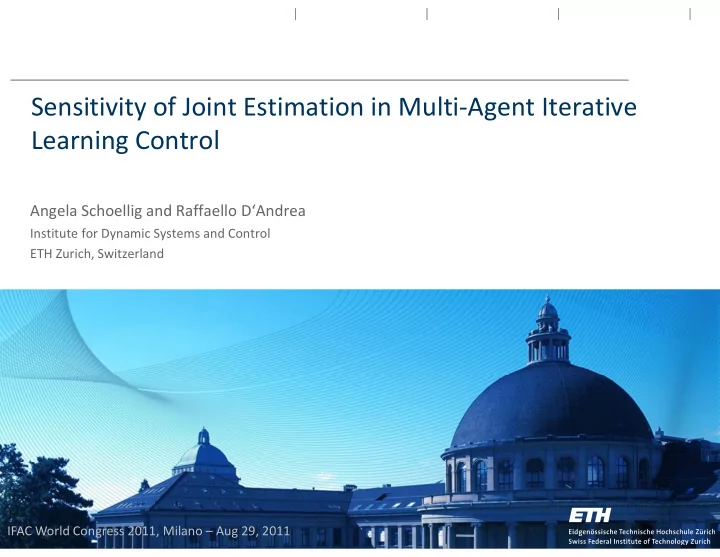

Sensitivity of Joint Estimation in Multi ‐ Agent Iterative Learning Control Angela Schoellig and Raffaello D‘Andrea Institute for Dynamic Systems and Control ETH Zurich, Switzerland 1 IFAC World Congress 2011, Milano – Aug 29, 2011
OUR FOCUS • Group of similar agents • Individual agents learn to perform a single ‐ agent task The task: learn to follow a trajectory • • Does sharing information speed up simultaneous learning? Angela Schoellig ‐ ETH Zurich 2
AGENTS ARE ABLE TO LEARN... Trajectory tracking with a quadrocopter. Full-length video. www.tiny.cc/QuadroLearnsTrajectory [Schoellig and D'Andrea, ECC 2009] [Schoellig, Mueller and D'Andrea, submitted to Autonomous Robots] 3
CAN AGENTS BENEFIT FROM EACH OTHER... …when learning the same task? Angela Schoellig ‐ ETH Zurich 4
PROBLEM STATEMENT Group of similar agents. Same nominal dynamics Physical model of real ‐ world system. Performing the same task. GOAL OF LEARNING: Follow the desired trajectory. Repeated and simultaneous operation. LEARNING OF OPEN ‐ LOOP CONTROL CORRECTIONS. Q1: Is an individual agent able to learn faster when performing a task simultaneously with a group of similar agents? Angela Schoellig ‐ ETH Zurich 5
LIFTED ‐ DOMAIN REPRESENTATION Linearize. Small deviations from nominal trajectory. Discretize. Linear, time ‐ varying difference equations. Lifted ‐ system representation. Static mapping representing one execution. With and Angela Schoellig ‐ ETH Zurich 6
SIMILAR BUT NOT IDENTICAL... For trial and agent Repetitive disturbance. Unknown. Constant over iterations. Agents differ in the unknown part. SIMILARITY ASSUMPTION. Noise. Unknown. Uncorrelated between iterations. Over iterations our knowledge on and changes… Angela Schoellig ‐ ETH Zurich 7
HOW DOES A SINGLE AGENT LEARN? EXECUTE NEW ITERATION (1) Estimate the repetitive disturbance by taking into ESTIMATE account all past measurements. Obtain . CORRECT (2) Correct for by updating the input. “Minimize” . For example, Can the disturbance estimate be improved by taking into account the measurements of the other agents? Angela Schoellig ‐ ETH Zurich 8
FOCUS: ESTIMATION PROBLEM INDEPENDENT ESTIMATION vs. JOINT ESTIMATION Angela Schoellig ‐ ETH Zurich 9
REDUCE MODEL DYNAMICS with neglect deterministic part assume independence of vector entries MEASUREMENT AND PROCESS NOISE with Angela Schöllig ‐ ETH Zürich 10
JOINT ESTIMATION Kalman filter for the joint problem. Estimation objective: System equation: Initial condition: SIMILARITY ASSUMPTION. LEMMA: We obtain covariance matrix in closed form. (Proof by induction) Special case: independent estimation Angela Schoellig ‐ ETH Zurich 11
COMPARISON JOINT LEARNING BENEFIT METRIC: ratio of state covariances of independent vs. joint estimation If R > 1, joint learning is beneficial. The VARIANCE OF THE STATE ESTIMATE is a measure for the learning performance (=experimental outcome). with Angela Schoellig ‐ ETH Zurich 12
RESULT Performance increase due to joint estimation: THEOREM 1: Pure Process Noise limit case for THEOREM 2: Pure Measurement Noise limit case for [Schoellig, Alonso-Mora and D'Andrea; CDC 2010, accepted AJC] Angela Schoellig ‐ ETH Zurich 13
SUMMARY Under the given assumptions, joint estimation ... • improves the performance of an individual agent • the benefit is only significant if (1) agents are highly similar AND (2) process noise is negligible AND (3) common disturbance large compared to the measurement noise Q2: How critical is the underlying similarity assumption? Angela Schoellig ‐ ETH Zurich 14
SIMILARITY ASSUMPTION True values. For Defines degree of similarity. ASSUME THAT DEGREE OF SIMILARITY IS UNKNOWN. Nominal values (“our best guess“). SOLVE KALMAN FILTER EQUATIONS UNDER NEW ASSUMPTIONS Angela Schoellig ‐ ETH Zurich 15
SENSITIVITY ANALYSIS − RESULTS JOINT ESTIMATION PERFORMANCE IS DEGRADED. Underestimate similarity LEMMA: Sufficient condition Joint estimation remains beneficial. Worst case. Assume agents are identical and they are not, then joint estimation does NOT converge. Angela Schoellig ‐ ETH Zurich 16
CONCLUSION In the proposed framework, where we learn open ‐ loop input corrections... TAKE HOME MESSAGE: (1) Joint learning good only if high similarity of unknown disturbance can be guaranteed (2) For joint learning, it‘s always safer to underestimate similarity. Choose independent learning as default since benefit of joint learning is minor for most cases. Angela Schoellig ‐ ETH Zurich 17
Sensitivity of Joint Estimation in Multi ‐ Agent Iterative Learning Control Angela Schoellig and Raffaello D‘Andrea Institute for Dynamic Systems and Control ETH Zurich, Switzerland 18 IFAC World Congress 2011, Milano – Aug 29, 2011
Recommend
More recommend